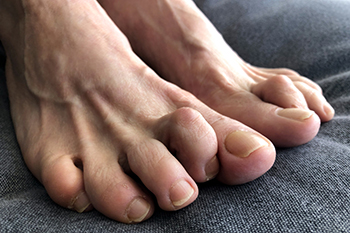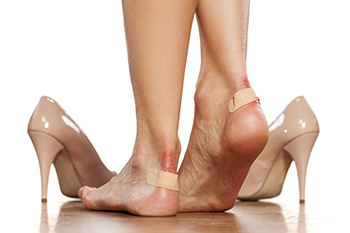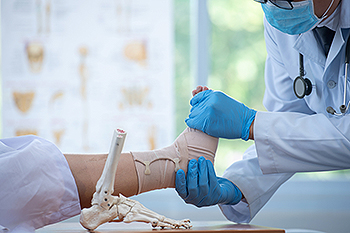Items filtered by date: May 2025
Heel Pain Can Be Treated!
Understanding Hammertoe Deformity

A hammertoe is a bending deformity that usually affects the second, third, or fourth toe, causing the middle joint to become stuck in a bent position. This can make the toe appear curled and may lead to discomfort, pressure, and difficulty wearing shoes. Hammertoes often develop due to muscle imbalance, foot structure, arthritis, or wearing shoes that are too tight or narrow. Corns or calluses may form on the top of the toe where it rubs against footwear. Early stages may allow for some flexibility, but over time, the toe can become rigid. Treatment includes wearing roomier shoes, using protective padding, or trying custom orthotics to improve alignment and reduce pressure. In more advanced cases, surgery may be considered to correct the deformity. If your toe is becoming painful, stiff, or difficult to move, it is suggested that you consult a podiatrist for proper care and guidance.
Hammertoes can be a painful condition to live with. For more information, contact Brock Liden, DPM of Ohio. Our doctor will answer any of your foot- and ankle-related questions.
Hammertoe
Hammertoe is a foot deformity that occurs due to an imbalance in the muscles, tendons, or ligaments that normally hold the toe straight. It can be caused by the type of shoes you wear, your foot structure, trauma, and certain disease processes.
Symptoms
- Painful and/or difficult toe movement
- Swelling
- Joint stiffness
- Calluses/Corns
- Physical deformity
Risk Factors
- Age – The risk of hammertoe increases with age
- Sex – Women are more likely to have hammertoe compared to men
- Toe Length – You are more likely to develop hammertoe if your second toe is longer than your big toe
- Certain Diseases – Arthritis and diabetes may make you more likely to develop hammertoe
Treatment
If you have hammertoe, you should change into a more comfortable shoe that provides enough room for your toes. Exercises such as picking up marbles may strengthen and stretch your toe muscles. Nevertheless, it is important to seek assistance from a podiatrist in order to determine the severity of your hammertoe and see which treatment option will work best for you.
If you have any questions, please feel free to contact our office located in Circleville, OH . We offer the newest diagnostic and treatment technologies for all your foot care needs.
What Is a High Ankle Sprain?

A high ankle sprain occurs when the ligaments above the ankle that connect the two bones in your lower leg, the tibia and fibula, are stretched or torn. This type of sprain is less common but often more severe than an ankle sprain that affects the ligaments surrounding the ankle joint. High ankle sprains are usually caused by a twisting injury or direct impact, often seen in sports like football, basketball, or skiing. Symptoms include pain above the ankle, swelling, bruising, and difficulty walking or bearing weight on the affected foot. The pain is often sharp and may worsen with activity or when the foot is rotated. A podiatrist can evaluate the severity of the sprain through a physical exam and imaging, offering treatments such as rest, elevation, immobilization, and, in some cases, targeted exercises. In more severe cases, surgery may be required. If you have a painful ankle sprain, it is suggested that you promptly schedule an appointment with a podiatrist.
Ankle sprains are common but need immediate attention. If you need your feet checked, contact Brock Liden, DPM from Ohio. Our doctor can provide the care you need to keep you pain-free and on your feet.
How Does an Ankle Sprain Occur?
Ankle sprains take place when the ligaments in your ankle are torn or stretched beyond their limits. There are multiple ways that the ankle can become injured, including twisting or rolling over onto your ankle, putting undue stress on it, or causing trauma to the ankle itself.
What Are the Symptoms?
- Mild to moderate bruising
- Limited mobility
- Swelling
- Discoloration of the skin (depending on severity)
Preventing a Sprain
- Wearing appropriate shoes for the occasion
- Stretching before exercises and sports
- Knowing your limits
Treatment of a Sprain
Treatment of a sprain depends on the severity. Many times, people are told to rest and remain off their feet completely, while others are given an air cast. If the sprain is very severe, surgery may be required.
If you have suffered an ankle sprain previously, you may want to consider additional support such as a brace and regular exercises to strengthen the ankle.
If you have any questions please feel free to contact our office located in Circleville, OH . We offer the newest diagnostic and treatment technologies for all your foot and ankle needs.
When Foot Blisters Get In the Way

Foot blisters are small pockets of fluid that form from repeated friction, often caused by wearing tight shoes, sweaty feet, or long periods of walking. They usually appear on the toes, heels, or soles and can be painful or tender. While it may be tempting to pop a blister, doing so increases the risk of infection. Instead, keep it clean, dry, and protected with a bandage or blister pad. Letting the blister heal naturally is best when possible. If it breaks, clean it gently and cover it with a clean dressing. Wearing moisture-wicking socks and properly fitted shoes can help prevent future blisters. For athletes or those with diabetes, blisters should be watched closely. If a blister becomes red, warm or filled with pus, it is suggested you see a podiatrist for appropriate treatment.
Blisters are prone to making everyday activities extremely uncomfortable. If your feet are hurting, contact Brock Liden, DPM of Ohio. Our doctor can provide the care you need to keep you pain-free and on your feet.
Foot Blisters
Foot blisters develop as a result of constantly wearing tight or ill-fitting footwear. This happens due to the constant rubbing from the shoe, which can often lead to pain.
What Are Foot Blisters?
A foot blister is a small fluid-filled pocket that forms on the upper-most layer of the skin. Blisters are filled with clear fluid and can lead to blood drainage or pus if the area becomes infected.
How Do Blisters Form?
Blisters on the feet are often the result of constant friction of skin and material, usually by shoe rubbing. Walking in sandals, boots, or shoes that don’t fit properly for long periods of time can result in a blister. Having consistent foot moisture and humidity can easily lead to blister formation.
Prevention & Treatment
It is important to properly care for the affected area in order to prevent infection and ease the pain. Do not lance the blister and use a Band-Aid to provide pain relief. Also, be sure to keep your feet dry and wear proper fitting shoes. If you see blood or pus in a blister, seek assistance from a podiatrist.
If you have any questions, please feel free to contact our office located in Circleville, OH . We offer the newest diagnostic and treatment technologies for all your foot care needs.
Understanding How Ankle Fractures Happen

Ankle fractures occur when one or more of the bones that form the ankle joint break due to sudden or excessive force. Car accidents are a common cause, as the impact can twist or crush the ankle unexpectedly. Falling and tripping, especially on uneven surfaces, often result in awkward landings that place too much stress on the joint. Simple missteps, such as missing a curb or stepping wrong on a slope, can also lead to fractures. Overuse injuries, particularly in athletes, may weaken the bones over time, making them more vulnerable to breaks. Another frequent cause is falling from a height, such as slipping off a ladder, where the force of landing improperly can easily fracture the ankle. If you have fractured your ankle, it is suggested that you contact a podiatrist who can offer appropriate treatment solutions.
Broken ankles need immediate treatment. If you are seeking treatment, contact Brock Liden, DPM from Ohio. Our doctor can provide the care you need to keep you pain-free and on your feet.
Broken Ankles
A broken ankle is experienced when a person fractures their tibia or fibula in the lower leg and ankle area. Both of these bones are attached at the bottom of the leg and combine to form what we know to be our ankle.
When a physician is referring to a break of the ankle, he or she is usually referring to a break in the area where the tibia and fibula are joined to create our ankle joint. Ankles are more prone to fractures because the ankle is an area that suffers a lot of pressure and stress. There are some obvious signs when a person experiences a fractured ankle, and the following symptoms may be present.
Symptoms of a Fractured Ankle
- Excessive pain when the area is touched or when any pressure is placed on the ankle
- Swelling around the area
- Bruising of the area
- Area appears to be deformed
If you suspect an ankle fracture, it is recommended to seek treatment as soon as possible. The sooner you have your podiatrist diagnose the fracture, the quicker you’ll be on the way towards recovery.
If you have any questions, please feel free to contact our office located in Circleville, OH . We offer the newest diagnostic and treatment technologies for all your foot care needs.

